+ Open data
Open data
- Basic information
Basic information
| Entry |  | |||||||||
|---|---|---|---|---|---|---|---|---|---|---|
| Title | Structure of FCP trimer in Cyclotella meneghiniana | |||||||||
 Map data Map data | ||||||||||
 Sample Sample |
| |||||||||
 Keywords Keywords | Cm-FCP-trimer /  PHOTOSYNTHESIS PHOTOSYNTHESIS | |||||||||
| Biological species |  Stephanocyclus meneghinianus (Diatom) Stephanocyclus meneghinianus (Diatom) | |||||||||
| Method |  single particle reconstruction / single particle reconstruction /  cryo EM / Resolution: 2.72 Å cryo EM / Resolution: 2.72 Å | |||||||||
 Authors Authors | Shen LL / Li ZH / Shen JR / Wang WD | |||||||||
| Funding support |  China, 1 items China, 1 items
| |||||||||
 Citation Citation |  Journal: Nat Commun / Year: 2023 Journal: Nat Commun / Year: 2023Title: Structural insights into photosystem II supercomplex and trimeric FCP antennae of a centric diatom Cyclotella meneghiniana. Authors: Songhao Zhao / Lili Shen / Xiaoyi Li / Qiushuang Tao / Zhenhua Li / Caizhe Xu / Cuicui Zhou / Yanyan Yang / Min Sang / Guangye Han / Long-Jiang Yu / Tingyun Kuang / Jian-Ren Shen / Wenda Wang /   Abstract: Diatoms are dominant marine algae and contribute around a quarter of global primary productivity, the success of which is largely attributed to their photosynthetic capacity aided by specific ...Diatoms are dominant marine algae and contribute around a quarter of global primary productivity, the success of which is largely attributed to their photosynthetic capacity aided by specific fucoxanthin chlorophyll-binding proteins (FCPs) to enhance the blue-green light absorption under water. We purified a photosystem II (PSII)-FCPII supercomplex and a trimeric FCP from Cyclotella meneghiniana (Cm) and solved their structures by cryo-electron microscopy (cryo-EM). The structures reveal detailed organizations of monomeric, dimeric and trimeric FCP antennae, as well as distinct assemblies of Lhcx6_1 and dimeric FCPII-H in PSII core. Each Cm-PSII-FCPII monomer contains an Lhcx6_1, an FCP heterodimer and other three FCP monomers, which form an efficient pigment network for harvesting energy. More diadinoxanthins and diatoxanthins are found in FCPs, which may function to quench excess energy. The trimeric FCP contains more chlorophylls c and fucoxanthins. These diversified FCPs and PSII-FCPII provide a structural basis for efficient light energy harvesting, transfer, and dissipation in C. meneghiniana. | |||||||||
| History |
|
- Structure visualization
Structure visualization
| Supplemental images |
|---|
- Downloads & links
Downloads & links
-EMDB archive
| Map data |  emd_36054.map.gz emd_36054.map.gz | 31.9 MB |  EMDB map data format EMDB map data format | |
|---|---|---|---|---|
| Header (meta data) |  emd-36054-v30.xml emd-36054-v30.xml emd-36054.xml emd-36054.xml | 15 KB 15 KB | Display Display |  EMDB header EMDB header |
| FSC (resolution estimation) |  emd_36054_fsc.xml emd_36054_fsc.xml | 8.4 KB | Display |  FSC data file FSC data file |
| Images |  emd_36054.png emd_36054.png | 39.6 KB | ||
| Filedesc metadata |  emd-36054.cif.gz emd-36054.cif.gz | 5.3 KB | ||
| Others |  emd_36054_half_map_1.map.gz emd_36054_half_map_1.map.gz emd_36054_half_map_2.map.gz emd_36054_half_map_2.map.gz | 59.4 MB 59.4 MB | ||
| Archive directory |  http://ftp.pdbj.org/pub/emdb/structures/EMD-36054 http://ftp.pdbj.org/pub/emdb/structures/EMD-36054 ftp://ftp.pdbj.org/pub/emdb/structures/EMD-36054 ftp://ftp.pdbj.org/pub/emdb/structures/EMD-36054 | HTTPS FTP |
-Related structure data
| Related structure data | 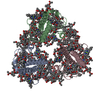 8j7zMC 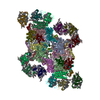 8j5kC 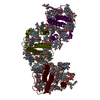 8w4oC 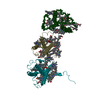 8w4pC M: atomic model generated by this map C: citing same article ( |
|---|
- Links
Links
| EMDB pages |  EMDB (EBI/PDBe) / EMDB (EBI/PDBe) /  EMDataResource EMDataResource |
|---|
- Map
Map
| File |  Download / File: emd_36054.map.gz / Format: CCP4 / Size: 64 MB / Type: IMAGE STORED AS FLOATING POINT NUMBER (4 BYTES) Download / File: emd_36054.map.gz / Format: CCP4 / Size: 64 MB / Type: IMAGE STORED AS FLOATING POINT NUMBER (4 BYTES) | ||||||||||||||||||||
|---|---|---|---|---|---|---|---|---|---|---|---|---|---|---|---|---|---|---|---|---|---|
| Voxel size | X=Y=Z: 1.04 Å | ||||||||||||||||||||
| Density |
| ||||||||||||||||||||
| Symmetry | Space group: 1 | ||||||||||||||||||||
| Details | EMDB XML:
|
-Supplemental data
-Half map: #2
| File | emd_36054_half_map_1.map | ||||||||||||
|---|---|---|---|---|---|---|---|---|---|---|---|---|---|
| Projections & Slices |
| ||||||||||||
| Density Histograms |
-Half map: #1
| File | emd_36054_half_map_2.map | ||||||||||||
|---|---|---|---|---|---|---|---|---|---|---|---|---|---|
| Projections & Slices |
| ||||||||||||
| Density Histograms |
- Sample components
Sample components
-Entire : Cm-FCP-trimer
| Entire | Name: Cm-FCP-trimer |
|---|---|
| Components |
|
-Supramolecule #1: Cm-FCP-trimer
| Supramolecule | Name: Cm-FCP-trimer / type: complex / ID: 1 / Parent: 0 / Macromolecule list: #1 |
|---|---|
| Source (natural) | Organism:  Stephanocyclus meneghinianus (Diatom) Stephanocyclus meneghinianus (Diatom) |
-Macromolecule #1: FCP
| Macromolecule | Name: FCP / type: protein_or_peptide / ID: 1 Details: fcp05 (fucoxanthin chlorophyll a/c binding protein 05) Number of copies: 3 / Enantiomer: LEVO |
|---|---|
| Source (natural) | Organism:  Stephanocyclus meneghinianus (Diatom) Stephanocyclus meneghinianus (Diatom) |
| Molecular weight | Theoretical: 19.815451 KDa |
| Sequence | String: AFEDELGAQP PLGFFDPFGM LSGDCTQERF DRLRYVEIKH GRIAQLAFLG QIVTRAGIHL PGSINYAGDS FDSFPNGVAA LFGPNSIPT AGLVQIIAFI GVLECAFMRD VPGTGNEHVG DFRNGYIDFG WDSFDEETKL QKRAIELNNG RAAMMGILGL M VHEEIIPL GYDPDLPIIG HLQ |
-Macromolecule #2: (3S,3'S,5R,5'R,6S,6'R,8'R)-3,5'-dihydroxy-8-oxo-6',7'-didehydro-5...
| Macromolecule | Name: (3S,3'S,5R,5'R,6S,6'R,8'R)-3,5'-dihydroxy-8-oxo-6',7'-didehydro-5,5',6,6',7,8-hexahydro-5,6-epoxy-beta,beta-caroten-3'- yl acetate type: ligand / ID: 2 / Number of copies: 21 / Formula: A86 |
|---|---|
| Molecular weight | Theoretical: 658.906 Da |
-Macromolecule #3: CHLOROPHYLL A
| Macromolecule | Name: CHLOROPHYLL A / type: ligand / ID: 3 / Number of copies: 24 / Formula: CLA |
|---|---|
| Molecular weight | Theoretical: 893.489 Da |
| Chemical component information |  ChemComp-CLA: |
-Macromolecule #4: Chlorophyll c2
| Macromolecule | Name: Chlorophyll c2 / type: ligand / ID: 4 / Number of copies: 6 / Formula: KC2 |
|---|---|
| Molecular weight | Theoretical: 608.926 Da |
| Chemical component information |  ChemComp-KC2: |
-Macromolecule #5: Chlorophyll c1
| Macromolecule | Name: Chlorophyll c1 / type: ligand / ID: 5 / Number of copies: 3 / Formula: KC1 |
|---|---|
| Molecular weight | Theoretical: 610.941 Da |
| Chemical component information | 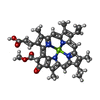 ChemComp-KC1: |
-Macromolecule #6: 1,2-DI-O-ACYL-3-O-[6-DEOXY-6-SULFO-ALPHA-D-GLUCOPYRANOSYL]-SN-GLYCEROL
| Macromolecule | Name: 1,2-DI-O-ACYL-3-O-[6-DEOXY-6-SULFO-ALPHA-D-GLUCOPYRANOSYL]-SN-GLYCEROL type: ligand / ID: 6 / Number of copies: 3 / Formula: SQD |
|---|---|
| Molecular weight | Theoretical: 795.116 Da |
| Chemical component information |  ChemComp-SQD: |
-Experimental details
-Structure determination
| Method |  cryo EM cryo EM |
|---|---|
 Processing Processing |  single particle reconstruction single particle reconstruction |
| Aggregation state | particle |
- Sample preparation
Sample preparation
| Buffer | pH: 6.5 |
|---|---|
| Vitrification | Cryogen name: ETHANE |
- Electron microscopy
Electron microscopy
| Microscope | FEI TITAN KRIOS |
|---|---|
| Electron beam | Acceleration voltage: 300 kV / Electron source:  FIELD EMISSION GUN FIELD EMISSION GUN |
| Electron optics | Illumination mode: FLOOD BEAM / Imaging mode: BRIGHT FIELD Bright-field microscopy / Nominal defocus max: 2.0 µm / Nominal defocus min: 1.0 µm Bright-field microscopy / Nominal defocus max: 2.0 µm / Nominal defocus min: 1.0 µm |
| Image recording | Film or detector model: GATAN K3 BIOQUANTUM (6k x 4k) / Average electron dose: 60.0 e/Å2 |
| Experimental equipment |  Model: Titan Krios / Image courtesy: FEI Company |
 Movie
Movie Controller
Controller







 Z
Z Y
Y X
X


















